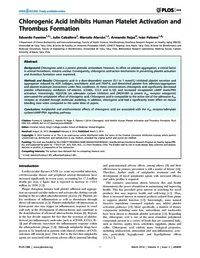Chlorogenic acid inhibits human platelet activation and thrombus formation
Fecha
2014Resumen
Background: Chlorogenic acid is a potent phenolic antioxidant. However, its effect on platelet aggregation, a critical factor
in arterial thrombosis, remains unclear. Consequently, chlorogenic acid-action mechanisms in preventing platelet activation
and thrombus formation were examined.
Methods and Results: Chlorogenic acid in a dose-dependent manner (0.1 to 1 mmol/L) inhibited platelet secretion and
aggregation induced by ADP, collagen, arachidonic acid and TRAP-6, and diminished platelet firm adhesion/aggregation
and platelet-leukocyte interactions under flow conditions. At these concentrations chlorogenic acid significantly decreased
platelet inflammatory mediators (sP-selectin, sCD40L, CCL5 and IL-1b) and increased intraplatelet cAMP levels/PKA
activation. Interestingly, SQ22536 (an adenylate cyclase inhibitor) and ZM241385 (a potent A2A receptor antagonist)
attenuated the antiplatelet effect of chlorogenic acid. Chlorogenic acid is compatible to the active site of the adenosine A2A
receptor as revealed through molecular modeling. In addition, chlorogenic acid had a significantly lower effect on mouse
bleeding time when compared to the same dose of aspirin.
Conclusions: Antiplatelet and antithrombotic effects of chlorogenic acid are associated with the A2A receptor/adenylate
cyclase/cAMP/PKA signaling pathway.
Fuente
Plos One, 9(3), e90699Identificador DOI
doi.org/10.1371/journal.pone.0090699Colecciones
La publicación tiene asociados los siguientes ficheros de licencia:



